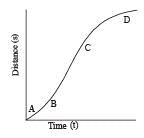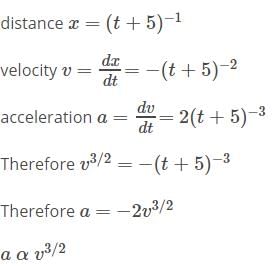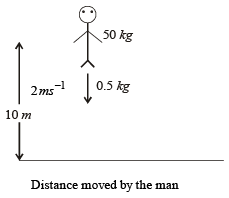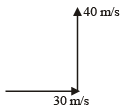31 Year NEET Previous Year Questions: Motion in a Straight Line - 1 - NEET MCQ
16 Questions MCQ Test Physics Class 11 - 31 Year NEET Previous Year Questions: Motion in a Straight Line - 1
A particle moving along x-axis has acceleration f, at time t, given by  , where f0 and T are constants. The particle at t = 0 has zero velocity. In the time interval between t = 0 and the instant when f = 0, the particle’s velocity (vx) is
, where f0 and T are constants. The particle at t = 0 has zero velocity. In the time interval between t = 0 and the instant when f = 0, the particle’s velocity (vx) is
[2007]
 , where f0 and T are constants. The particle at t = 0 has zero velocity. In the time interval between t = 0 and the instant when f = 0, the particle’s velocity (vx) is
, where f0 and T are constants. The particle at t = 0 has zero velocity. In the time interval between t = 0 and the instant when f = 0, the particle’s velocity (vx) is[2007]
The distance travelled by a particle starting from rest and moving with an acceleration 4/3ms-2 , in the third second is:

A particle shows distance - time curve as given in this figure. The maximum instantaneous velocity of the particle is around the point: [2008]

A particle moves in a straight line with a constant acceleration. It changes its velocity from 10 ms–1 to 20 ms–1 while passing through a distance 135 m in t second. The value of t is: [2008]
A bus is moving with a speed of 10 ms–1 on a straight road. A scooterist wishes to overtake the bus in 100 s. If the bus is at a distance of 1 km from the scooterist, with what speed should the scooterist ch ase the bus? [2009]
A particle starts its motion from rest under the action of a constant force. If the distance covered in first 10 seconds is S1 and that covered in the first 20 seconds is S2, then: [2009]
A ball is dropped from a high rise platform at t = 0 starting from rest. After 6 seconds another ball is thrown downwards from the same platform with a speed v. The two balls meet at t = 18s.What is the value of v? [2010] (take g = 10 m/s2)
A particle h as in itial velocity  and has acceleration
and has acceleration  . It's speed after 10 s is:
. It's speed after 10 s is:
A particle moves a distance x in time t according to equation x = (t + 5)-1. The acceleration of particle is proportional to [2010]
A man of 50 kg mass is standing in a gravity free space at a height of 10 m above the floor. He throws a stone of 0.5 kg mass downwards with a speed 2 m/s. When the stone reaches the floor, the distance of the man above the floor will be:
A boy standing at the top of a tower of 20m height drops a stone. Assuming g = 10 ms–2, the velocity with which it hits the ground is [2011]
A body is moving with velocity 30 m/s towards east. After 10 seconds its velocity becomes 40 m/s towards north. The average acceleration of the body is [2011]
A particle covers half of its total distance with speed v1 and the rest half distance with speed v2. Its average speed during the complete journey is
The motion of a particle along a straight line is described by equation : [2012] x = 8 + 12t – t3 where x is in metre and t in second. The retardation of the particle when its velocity becomes zero, is :
A stone falls freely under gravity. It covers distances h1, h2 and h3 in the first 5 seconds, the next 5 seconds and the next 5 seconds respectively. The relation between h1, h2 and h3 is [NEET 2013]
The displacement ‘x’ (in meter) of a particle of mass ‘m’ (in kg) moving in one dimension under the action of a force, is related to time ‘t’ (in sec) by t =  . The displacement of the particle when its velocity is zero, will be [NEET Kar. 2013]
. The displacement of the particle when its velocity is zero, will be [NEET Kar. 2013]
|
97 videos|379 docs|103 tests
|

















 is maximum at C and hence the instantaneous velocity is maximum at C.
is maximum at C and hence the instantaneous velocity is maximum at C.

















































